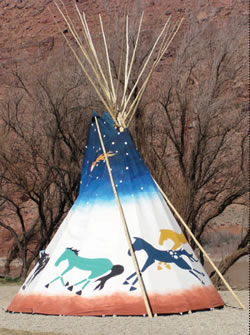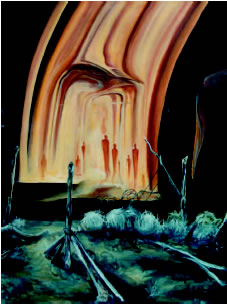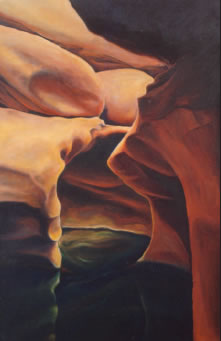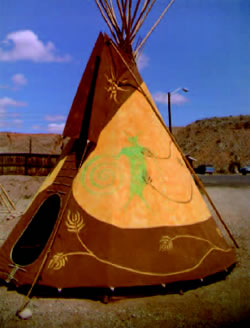|
 Sunnie
Holland is a native
Moabite, who recently finished her BFA in the visual arts
at Westminster College in Salt Lake City. She is now back
in Moab, actively creating a career in the arts through a
variety of projects and media. Her current work at Moab Outback,
as a tipi painter, focuses primarily on large-scale painting
and graphic design. Sunnie
Holland is a native
Moabite, who recently finished her BFA in the visual arts
at Westminster College in Salt Lake City. She is now back
in Moab, actively creating a career in the arts through a
variety of projects and media. Her current work at Moab Outback,
as a tipi painter, focuses primarily on large-scale painting
and graphic design.
If you have not seen the tipis at Moab Outback, as Mill Creek
Drive rounds into Spanish Valley, I encourage you to take
a drive out there. The tipi is an alluring three-dimensional,
conical structure to which designs and colors can be painted.
The word tipi comes from Sioux meaning “for living in”.
Moab Outback specializes in hand painted tipis “for
living in” or for a variety of other purposes. Holland
painted the wheat tipi, which stands proudly in the parking
lot, showing the traditional colors of yellow and brown and
traditional motifs, such as the wheat and the petroglyph figures.
The wheat tipi, like the other tipis at Moab Outback, was
painted with acrylic exterior house paint, which is durable,
long lasting and comes in a variety of colors. Holland struck
me as satisfied and stimulated by the creative process of
tipi painting and the way in which it allows her to be both
a graphic designer and a mural painter.
 When
I interviewed Holland she was painting the night sky of a
20-foot tipi for the Red Cliffs Lodge. She explained to me
that there are several steps to the creative process of painting
a finished tipi. First, if it is a custom tipi, she asks the
client a variety of questions about his/her likes, interests,
and uses for the tipi. Then she creates a custom design, using
a computer graphics program, out of the information she gathered
from the client. For the Red Cliffs tipi, the client was interested
in horses for a set of three tipis. Holland created a series
designs that showed galloping horses in a set of compositions,
all unified by the horse theme and the colors. When
I interviewed Holland she was painting the night sky of a
20-foot tipi for the Red Cliffs Lodge. She explained to me
that there are several steps to the creative process of painting
a finished tipi. First, if it is a custom tipi, she asks the
client a variety of questions about his/her likes, interests,
and uses for the tipi. Then she creates a custom design, using
a computer graphics program, out of the information she gathered
from the client. For the Red Cliffs tipi, the client was interested
in horses for a set of three tipis. Holland created a series
designs that showed galloping horses in a set of compositions,
all unified by the horse theme and the colors.
The next step is stretching the 20 feet tall by 40 feet wide
canvas tipi in the studio. The cotton duck canvas is not usually
primed before the acrylic paint is applied to it, which means
that laying in the paint must be decisive and final. Acrylic
paint is an unforgiving and unpredictable medium, like watercolor,
when laid into raw canvas. It takes a lot of technical skill
for Holland to know how to lay out her design on such a large
scale, as well as paint directly onto the canvas in bold bright
colors. Holland credited her mother, Page Holland, who painted
tipis for Moab Outback in the past. Page taught her technical
skills and techniques particular to tipi painting on canvas,
such as the sponge painting technique, which allows Holland
to paint the night sky uniformly and with subtle gradations
of dark blue tones.
 Although
we did not talk much about Holland’s personal fine art
painting, she submitted some prints to me showing a collection
of paintings, which combined the local landscape with the
human figure. Some of the paintings show people in active
relationship to the land through hiking, rapelling, and river
rafting. The other paintings show scenes depicting slot canyons,
caves, and rock art panels. The collection of paintings seems
to express Holland’s love for her home in the Canyonlands.
One painting in particular struck me as expressing Holland’s
interior relationship to the Canyonlands, - a painting entitled
Archive. Archive shows a lighted pictograph
panel as seen through a densely shadowed foreground. In this
painting Holland expresses emotion through a contrast of warm
and cool colors. The foreground expresses a sense of loneliness
and isolation in the human condition through the portrayal
of the dilapidated barbed wire fence and clusters of dry weeds
painted in cool blue tones. In contrast, the background is
a lit wall panel painted in strong golden, orange and red
hues. The pictograph figures are like warm shadows, silhouettes
of an everlasting spiritual presence in the canyons. The arced
lines of the panel and the sharp verticals in the foreground
lead the eye upwards, adding to the illusion that the pictograph
figures are ascending. This painting seems to best express
Holland’s intimate relationship with the Canyonlands,
both its haunting isolation and its comforting spiritual presence. Although
we did not talk much about Holland’s personal fine art
painting, she submitted some prints to me showing a collection
of paintings, which combined the local landscape with the
human figure. Some of the paintings show people in active
relationship to the land through hiking, rapelling, and river
rafting. The other paintings show scenes depicting slot canyons,
caves, and rock art panels. The collection of paintings seems
to express Holland’s love for her home in the Canyonlands.
One painting in particular struck me as expressing Holland’s
interior relationship to the Canyonlands, - a painting entitled
Archive. Archive shows a lighted pictograph
panel as seen through a densely shadowed foreground. In this
painting Holland expresses emotion through a contrast of warm
and cool colors. The foreground expresses a sense of loneliness
and isolation in the human condition through the portrayal
of the dilapidated barbed wire fence and clusters of dry weeds
painted in cool blue tones. In contrast, the background is
a lit wall panel painted in strong golden, orange and red
hues. The pictograph figures are like warm shadows, silhouettes
of an everlasting spiritual presence in the canyons. The arced
lines of the panel and the sharp verticals in the foreground
lead the eye upwards, adding to the illusion that the pictograph
figures are ascending. This painting seems to best express
Holland’s intimate relationship with the Canyonlands,
both its haunting isolation and its comforting spiritual presence.
Holland’s personal work and her tipi painting both appear
to be in harmony with one another. They both reflect her love
for her native home and for its cultural, historical, and
geological heritage. Her paintings, in any medium, give creative
voice to her personal, intimate relationship to the land and
to the earth - a relationship that speaks of the life cycles,
nurturing, growth and spirituality.
Sunnie Holland’s custom tipi design can be seen at Moab
Outback at 259-2667. She will also be facilitating a mural
for kids at the Moab Arts Festival, sponsored by the Moab
Arts and Recreation Center. Call the MARC at 259-6272 for
more details.
 
|